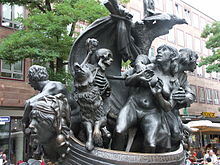- Ship of Fools (satire)
-
Ship of Fools (Modern German: Das Narrenschiff, Latin: Stultifera Navis, original medieval German title: Daß Narrenschyff ad Narragoniam) is a satire published 1494 in Basel, Switzerland by Sebastian Brant, a conservative German theologian.
In a prologue, 112 brief satires, and an epilogue, all illustrated with woodcuts, it is notable for including the first commissioned work by the great Renaissance artist-engraver Albrecht Dürer. Much of the work was critical of the current state of the Church. Brant here lashes with unsparing vigour the weaknesses and vices of his time. Here he conceives Saint Grobian, whom he imagines to be the patron saint of vulgar and coarse people.
The Ship of Fools was inspired by a frequent motif in medieval art and Literature, and particularly in religious satire, due to a pun on the Latin word "navis", which means a boat and also the nave of a church.
The concept of foolishness was a frequently used trope in the pre-Reformation period to legitimate criticism, as also used by Erasmus in his In Praise of Folly and Martin Luther in his Address to the Christian Nobility. Court fools were allowed to say much what they wanted; by writing his work in the voice of the fool, Brant could legitimise his criticism of the church.
The work immediately became extremely popular, with six authorised and seven pirated editions published before 1521. Brant did not support the Reformation movement, but many of the criticisms of the church expressed in his work mirrored themes which the reformers would pick up on.
The book was translated into Latin by Jacob Locher in 1497, into French by Paul Riviere in 1497 and by Jehan Droyn in 1498, into English by Alexander Barclay in 1509 and by Henry Watson also in 1509. Many wood-cuts of the first edition are believed to have been carved by Durer. The additional wood-cuts are the work of the so called Haintz-Nar-Meister, the Gnad-Her-Meister and two other anonymous artists. An allegorical painting by Hieronymus Bosch (that is a fragment of a triptych) was inspired by the 1494 German classic: The Ship of Fools (painting), 1490-1500. Exhibited in Louvre, Paris. Some 20th century artists (including Art Hazelwood, Dusan Kállay, István Orosz, Brian Williams) made images based on "Das Narrenschiff", or drew illustrations for contemporary editions of The Ship of Fools.
References
W Gillis, trans, The Ship of Fools, (1971)
External links
- Digitized version from the University of Houston 1498
- Ship of Fools online exhibit 1509 from the Glasgow University
Categories:- 1494 books
- Satirical books
Wikimedia Foundation. 2010.



